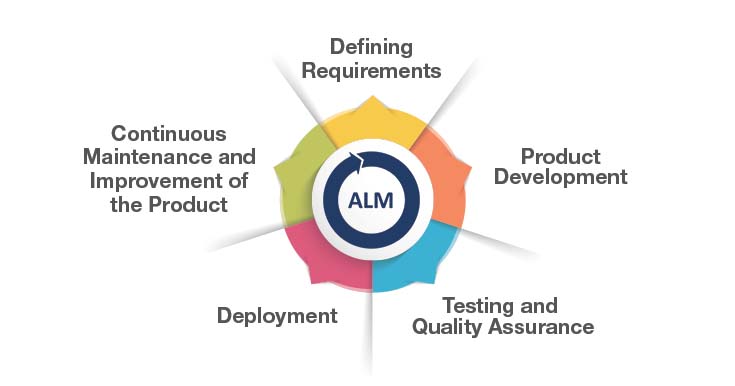What is Application Lifecycle Management (ALM)? Best Tools in 2024

Overview
There are many businesses in this digital era that cannot do without applications. They help to streamline internal operations and collect customer data, which is used for growth. However, building and maintaining these applications is not something done once but rather a journey. For this journey, you need a roadmap or a structured approach for quality assurance, efficiency, and ultimately success, which is Application Lifecycle Management (ALM). Let’s explore why ALM is and what the best application lifecycle management tools are in 2024.
What Is ALM?
The concept of ALM can be viewed as an all-embracing method for managing an application’s life cycle, starting from its inception until it is finally phased out to use. It incorporates all processes, approaches, and application lifecycle management tools used in planning, designing, testing, deploying, running, and even enhancing your application as applicable. Just think of it like an elaborate map that will guide your ALM software developers to quickly transition from having thoughts about some software product to getting fully functional software.
Why Do You Need ALM?
The following are key advantages of adopting robust ALM practices within your organization:
- Enhanced Quality and Reduced Risks: This involves putting in place a controlled development process that minimizes errors and defects. One way of achieving this is by using a rigorous ALM testing tool at every stage.
- Improved Efficiency and Productivity: Application lifecycle management tools improve efficiency and productivity by enhancing the communication and collaboration between numerous teams involved in the development cycle. This encourages better distribution of resources, which minimizes rework and ultimately accelerates application delivery.
- Efficient Cost Management: ALM controls expenses associated with bug fixes and subsequent rework during late stages in the lifecycle by proactively identifying and resolving issues at an early stage.
- Increased Customer Satisfaction: Happy customers are achieved through the delivery of quality applications on time. By ensuring that your applications meet customer needs and wants, ALM results in higher levels of customer satisfaction as well as loyalty.
- Better Compliance with Regulations: There are specific regulations for ALM software development in some industries. A clear audit trail is maintained by ALM while ensuring regulatory compliance.
What is ALM Used For?
Application Lifecycle Management (ALM) refers to the abbreviation of ALM. This concept involves managing a software application through its whole life cycle; starting from initial planning and designing, through development, testing, deployment up to maintenance even. Think about it as an organization or tracking system for your software.
Stages of ALM

ALM assumes a critical role throughout the different phases of an application’s lifecycle:
- Defining Requirements: In its capacity as an effective requirement-capture, documentation, and management tool, ALM ensures that all stakeholders are on the same page and that development efforts are congruent with user needs.
- Product Development: Developers, designers, plus other team members can work together through this platform (ALM). It provides a central platform for code management, version control, and task tracking, streamlining the development process.
- Testing and Quality Assurance: ALM enforces rigorous methods of testing. Different types of tests are planned and executed at various stages of development to ensure that all bugs are eliminated from the application, thus making it a high-quality product.
- Deployment: In this regard, ALM allows for easy deployment of your application into multiple environments without any downtime since this whole process is controllable.
- Continuous Maintenance and Improvement of the Product: The implementation does not stop at deployment. Instead, it assists you in dealing with ongoing maintenance, bug fixing, and new feature development, which will keep ALM software current and safe.
Benefits of Application Lifecycle Management
These are some advantages which can be gained through a strong ALM strategy:
- Better software quality: When there are fewer errors or faults then such an app becomes more secure both for customers and developers.
- Faster development time: With well-coordinated approaches among team members as well as between different teams working on various parts of an application program interface (API), integration points etcetera will greatly quicken the overall project completion schedule.
- Lower costs: This is achieved by early identification plus correction of problems, thereby reducing rework and other related consequences.
- Higher ROI: Shortest project cycle times coupled with better quality applications lead to increased returns on investments made towards such endeavors as software development life cycle management systems implementation projects among others.
- More compliance: Adherence to industry regulations can be ensured by following proper procedures during each stage according to relevant security standards set forth under appropriate legal frameworks.
- Improved stakeholder satisfaction: The stakeholders are informed about the company policies through clear communication channels that occur from a well-defined process all throughout the life span of a product under development.
How Does ALM Compare With Other Lifecycle Management Methodologies?
While ALM may appear to be a difficult system, we need to understand how it interacts with other software development lifecycle (SDLC) methodologies, especially the SDLC itself. Here is the main difference:
ALM vs SDLC
- ALM is broader: Consider ALM the complete journey, from conception to retirement. It’s like passing through each step and process involved in this expedition.
- SDLC is focused: In contrast, SDLC focuses on a single part of this journey – the development stages. It emphasizes such activities as coding, testing, and deployment among others that are involved in building the software itself.
ALM contains SDLC methodologies within its ambit. Consider it as a cook’s cookbook. In other words, the recipe book (ALM) details everything about preparing meals, from acquiring ingredients (planning) to cooking and serving them (development and deployment). However, there are specific instructions for each step within that recipe book, such as how to slice vegetables (a mini-process out of a bigger cooking stage). These specific instructions are similar to those of the SDLC methodologies under ALM.
What does application governance mean in the context of ALM?
Application Governance (AppGov) is an important aspect of the ALM tool that ensures proper oversight and control over the application lifecycle. It provides policies, procedures, and rules for managing applications from their birth until they die. AppGov ensures that apps are aligned with business objectives, meet regulatory compliance requirements, and mitigate security risks.
What are ALM Tools?
Application Lifecycle Management tools (or ALM tools) can be defined as software applications that can automate a number of tasks within an ALM process. These solutions may either come together into one platform or be provided separately. Some major features found in popular Application Lifecycle Management Tools include:
- Requirements Management: Capture, document, track, and manage user requirements.
- Change Management: Control changes to the application during its lifecycle.
- Development Application Lifecycle Management Tools: Aid in code development, version control, collaboration, etc.
- Testing Tools: Automate different types of testing such as functional testing, performance testing, security testing, etc.
- Deployment Application Lifecycle Management Tools: Automate and manage deployments to different environments
- Defect Management: Track defects reported during test run
- Reporting and Analytics: This function is aimed at providing input on how the system is functioning by generating reports on system performance and development.
ALM Tools that best suit the Enterprises in 2024!
To choose an application life cycle management tool; it is necessary to consider criteria such as the size, financial plan, and other needs of an organization. Here are some examples:
Microsoft Azure DevOps Server (formerly TFS)
A suite that manages all aspects of a software’s lifecycle: project management, development, testing, deployment, and operations. It easily integrates with other Microsoft tools and has an interface that is easy to use.
Atlassian Stack, which consists of Jira Software + Atlassian Intelligence + Confluence + Jira Service Management + Bitbucket + Bamboo / Bitbucket Pipelines
These are Atlassian’s integrated application lifecycle management tools covering various aspects of the ALM process. Jira Software majorly deals with the process of project administration and agile development while Confluence focuses on collaboration and knowledge sharing. For source code version control purposes, Bitbucket builds and deploys with either Bamboo or Bitbucket Pipelines. This suite will be complemented by Atlassian Intelligence as a business analytics.
GitHub Enterprise + GitHub Copilot + GitHub Projects + GitHub Wiki + GitHub Actions + Octopus Deploy
For companies deeply invested in the GitHub ecosystem, this offers a comprehensive solution. GitHub Enterprise delivers on-premises deployment of all the features in GitHub, while AI-powered code completion is also done by GitHub Copilot. GitHub Projects facilitates project management, and GitHub Wiki allows for collaborative knowledge creation. GitHub Actions automates workflows within the development process, and Octopus Deploy integrates seamlessly for deployment automation.
IBM Rational
Developing applications and managing their life cycles can be done with a range of application lifecycle management tools from IBM. DevTools help in adopting application lifecycle management.
How Can DevTools Help You With the Adoption of Application Lifecycle Management?
DevTools is ready to assist companies who want to adopt Application Lifecycle Management (ALM) through the best practice methodologies supported by the DevSecOps approach. Our suite of tools, together with procedures, ensures that we speed up the software development lifecycle, thus making it possible to adopt ALM practices easily. We integrate security, automation, and collaboration across all platforms with an approach based on DevSecOps principles aimed at enhancing security across various levels within an organization. DevTools helps businesses update their work methods and make them more efficient by using Agile consulting, Lean methods, and DevOps practices. This means we assist in making processes more flexible, cutting out unnecessary steps, and improving collaboration among teams. We focus on using automated tools and working together as a team to reach the goals a business wants to achieve. This way, we help companies reach their desired results faster while making sure they get the most value out of their efforts.
Conclusion
If you want to achieve your business goals in a cost-effective manner then ALM should be one of the things you give priority when creating an application because it helps to maximize output while minimizing input. It should be remembered that it is a continuous journey. Thus, being aware of the latest trends in ALM tool and keeping up-to-date with modern application lifecycle management tools are essential parts of optimizing your ALM software development processes. Therefore, you can also control the chaos of app development with a strong ALM plan and see your apps fly high to success!




